Positive Health Online
Your Country

Biodynamic Psychotherapy - Meeting the psyche in the body
by Clover Southwell(more info)
listed in bodywork, originally published in issue 66 - July 2001
Introduction
Biodynamic psychotherapy is the life work of Gerda Boyesen, the Norwegian psychologist and physiotherapist. It is based on a profound appreciation of the oneness of a person's body/mind/spirit, and integrates an enormously broad range of methods, addressing body and mind as one. We work not only with talking, but also with movements – both subtle and strong – and with many levels of 'hands-on' work, as well as with meditative and sensory awareness.
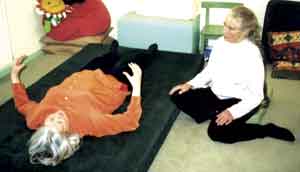
Cautiously the client explores the impinging impulse to reach out
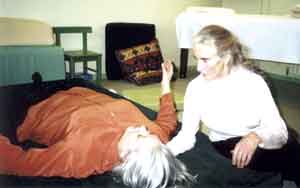
Softening the control of the neck tensions gives the impulse more chance
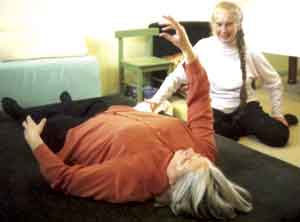
Enjoying the authentic movement
"We can become ill", says Gerda Boyesen, "simply from the repression of joy". She regards joy, well-being and spiritual connection as our very birthright: our natural human functioning. Anything less than this 'positive health' Gerda Boyesen regards as neurosis, which she sees as almost universal in our culture. She is dedicated to helping humanity recover its birthright.
Coming into a biodynamic therapy room, you'll find a couple of chairs, a massage table, plenty of room to move about, and a large mattress on the floor. This setting offers a multitude of possibilities for your session. You might lie on the big mattress, exploring the gentle movements of biodynamic orgonomy, with its surprisingly powerful effects. You might spend the session 'just sitting talking'. As perhaps your hand begins to make some little movement, and you begin to feel the 'stimuli impinging from within', you might recognize an unexpected impulse, feeling or memory. As the session proceeds, you might discover that some past experience is still strongly affecting your present life. You might have a treatment on the massage table, and find afterwards that, although the touch felt is light, its effect is amazingly profound.
Your session might involve a combination of very different methods, including what would conventionally be regarded as 'psychotherapy' together with what would conventionally be regarded as 'bodywork', such as movement, massage and exercises.
Biodynamic therapy is unique in embracing within one comprehensive therapeutic approach such a diversity of therapeutic methods. To regard them as the 'psychotherapy' methods on the one hand and the 'bodywork' ones on the other, is to miss the true depth of the work.
Gerda Boyesen's Professional Background
Gerda Boyesen developed biodynamic psychology and psychotherapy through a gradual and radical integration of the three very different strands of her knowledge and expertise: classical psychology, Reichian body- psychotherapy and hands-on bodywork, in particular the unique and powerful neuromuscular techniques developed by Adel Bulow-Hansen, at whose clinic she trained and then worked for a further two years.
Gerda Boyesen qualified as a clinical psychologist in Oslo in 1951; she also underwent a training analysis with Dr Ola Raknes, Wilhelm Reich's closest colleague in Norway. Additionally she qualified as a physiotherapist. She then had decades of experience working with classical psychodynamic psychotherapy, both in Norwegian mental hospitals and in private practice, where she also used and adapted the massage techniques she had learned.
For her own personal psychological development, Gerda Boyesen is convinced that the treatments from Bulow-Hansen had a far more transformative effect than all her other personal work. Her persistent searching for adequate explanations of the remarkable emotional effects of this form of massage led to her unique appreciation of how body and mind are in constant interaction. This inseparable interaction of body and mind is the basis of Gerda Boyesen's psychotherapeutic approach.
The Physical Aspects of Emotion and of Emotional Repression
All our emotions involve the responses of our body systems, though mostly we are unaware of this. As we get angry or scared, our breathing will change, our muscles may tense up, and with more blood coming into our action muscles, our digestive system slows down. Biodynamic theory sees all these changes as the up-going side of a far-ranging emotional cycle: a natural process of emotional arousal and subsidence, of tension followed by release, charge followed by discharge.
Gerda Boyesen emphasizes that we are 'designed' to recover completely from emotional stress: both the stress in our minds, and its all-pervasive effects in our bodies. According to her theory of psycho-peristalsis, emotional stress results in fluid pressure in the walls of the intestines. Once we are out of the emotional situation, and can rest again, our intestines should naturally discharge this pressure, squeezing the excess fluid out of the intestinal walls by peristaltic contractions. This completes the down-going side of the emotional cycle, our most fundamental self-regulation.
We may choose not to express an emotion, but if we can come to terms with our feelings, we can relax, let go of the emotion in our mind, and digest it also vegetatively, so that all the patterns of arousal leave our body systems. However, whereas in animals periods of arousal and outward activity alternate with periods of rest, recuperation and inner metabolic activity, our own culture vastly overemphasizes activity, effort, striving – 'doing' as apposed to 'being' – with far too little time for rest, reflection and recuperation.
Our natural self-regulation gets threatened very early in life. We learn to suppress our feelings, we deny them, we fail to resolve the emotional situation. We interrupt our emotional cycle. To suppress our feelings we have to use virtually all our body systems, the involuntary (autonomic) as well as the voluntary. From any one interruption, the distortion that results is microscopic. Repeated hundreds of times a day, the distortions build up into body armour. We lose our natural flexibility and self-regulation, and develop a neurotic structure of body and mind, affecting not just our muscles and our posture, but our inner organs and the very quality of our tissue.
Gerda Boyesen has shown that these vegetative changes have an enormous effect on our emotional outlook and well-being. Her vegetative massage methods gradually re-educate the 'psycho- peristalsis' to reduce the pressure of the 'energetic fluid' in the guts. If we are working with massage, the minute variations in gut sounds we can hear through a stethoscope lead us to the psychologically significant spots in our client's body.
Understanding and working with the psychological effects of vegetative disturbance is perhaps Gerda Boyesen's most radical contribution to the world of psychotherapy.
An Example of Integrative Biodynamic Psychotherapy
Because neurosis is structured into the body, biodynamic psychotherapy will work with the client's body at the same time as working with the mind.
When I first met F, her arms seemed to dangle, rather than growing out from her torso. Her hands were cold and lifeless, her fingers completely limp, and the coldness went right up to her elbow.
This was all part of a larger pattern of fear, structured into her body. Making contact with people is one of the primitive functions served by our arms. Difficulties in making contact lead to major disturbances in the physiology of the arms. F had a deep-seated fear of contact. When she felt insecure, she would close down her breathing and cross her arms in front of her, clamping her elbows tightly to her sides. Probably this is what she did as a child, hoping to make herself feel more secure. Her body had grown to adulthood in the grip of her fearfulness and timidity. And now the muscular and vegetative restrictions in her adult body literally embodied her past and present fears of the world, her misgivings about showing her real self. In working to loosen the bodily grip of these neurotic patterns, I was working directly with F's ingrained responses to life.
Through months of work, F's shyness began to ease, and she started to talk more freely in the sessions, though when feelings from childhood came nearer the surface she would often fall silent. On the conscious level F would enjoy the massage, and she trusted me. But, deeper inside, her body tissue was resisting, so that at first I was unable to warm up her hands. Eventually, over months of regular biodynamic massage, her hands began to 'thaw' and her breathing became freer. As her bodily restrictions began to open, many of the fear patterns governing her behaviour began to ease. She became more tactile, buying herself a velvet skirt because she liked the feeling. Gradually she got 'braver' in speaking with people, she started going out more, and began a new friendship. She was beginning to feel more in tune with herself, regaining some of her primary personality.
Clients come for biodynamic therapy with very different needs and with very different expectations. Not all bring obvious 'problems' or are desperately wounded, damaged or distressed. People also come because they are 'not getting enough out of life'. Some are suffering from a persistent symptom such as lower back pain, disturbed bowel function, stiff neck, or digestive upsets. These symptoms often prove to have a psychosomatic or psychovegetative aspect, and may get much easier as the person begins to feel more at ease generally.
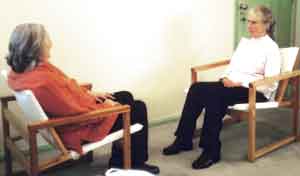
The client finds her own way to her own truth
The Primary Personality
At the very heart of biodynamic psychotherapy is our trust in the unique potential of each individual human being: what Gerda Boyesen calls their primary personality. This dynamic essence is potentially impelling the person towards self-realization, towards a wholeness of being that will embrace the spirituality inherent in human nature.
Many of us have lost our connection with our primary selves. We don't really know ourselves at this level. We restrain our exuberance, suppress our feelings, hide our fantasies, deny our spiritual experience, and repress our most troubling memories.
Gradually we develop a secondary personality. Though this secondary personality may serve us quite well in some aspects of life, it tragically limits the breadth and depth of our inner life, as well as the richness and authenticity of our relationships.
The core objective of biodynamic psychotherapy is to help a person reconnect with their primary potential. The more a person is in touch with this level and able to follow its promptings, the more fulfilling their life can be.
So biodynamic psychotherapy is a two-handed process. On the one hand we welcome every tiny sign of the emerging Primary, we trust it, we encourage it, strengthen it, whilst on the other hand we soften the grip of the Secondary (armour) overlaying it.
1. We encourage the client to let their hidden, buried primary potential emerge. We know this exists within everybody, however deeply buried under the protective secondary personality they have built up. The biodynamic therapist 'holds the vision' of this client's primary potential, and is curious to know more of this person, to see more, hear more;
2. We work to 'melt' the self-doubt, self-criticism, self-limitation with which this person undermines their natural potential. We are clearing the path for the primary energy, getting the secondary out of the way, getting the fear out of the way.
The Female Principle Enters Body-Psychotherapy
Though it has many parallels with Reichian approaches, Gerda Boyesen's work is infused throughout with the female, 'yin' principle, and this makes it significantly different. For instance, on the bodily level, her concern focuses more on the innermost vegetative processes than on the muscular armouring; on the psychological level, she focuses more on the underlying primary personality than on the overlaying secondary.
The biodynamic psychotherapist works like a midwife to the primary personality emerging in the client, bringing people in touch with their inner world. Biodynamic therapy is a deep awakening to one's inner being.
Our therapeutic attitude is one of active expectancy: inviting and receptive rather than penetrating; accepting more often than challenging. Typically we speak few words in the session; we avoid asking direct questions, or making suggestions, or giving interpretations. We simply encourage clients to say what they are moved to say, to explore their immediate experience, and find their own way to their own truth, trusting the natural spontaneous therapeutic process of growth and healing.
For both therapist and client, this is a process of creative unknowing, being open to the unexpected, willing to be surprised, as the unconscious comes to expression through the body, and through the images in the mind, rather than working to a pre-planned therapeutic programme. From second to second, we try to stay alive to every tiny change that comes in a person's breathing, face colour, posture, voice tone, as the session progresses, whether or not we are working directly with the body. These minutiae are movements of the emotional energy in the client. They all have their significance in the psychotherapeutic process.
Whether our client is lying on the mattress, moving in the room, receiving a massage, or 'just sitting talking', the session may involve the client remembering, re-living, finding a new way through a difficult emotional experience: a very conscious process of active exploration. Sometimes, as with F, the therapy may move largely below the level of conscious awareness. Each of the many different forms of biodynamic massage makes its particular contribution to the psychotherapeutic journey, whether strengthening the 'primary' in the client or 'melting the secondary', as the distorted or stagnated patterns of behaviour begin to fade, and a new ease of being is established.
The wide variety of methods we use reflects the breadth with which biodynamic therapy embraces the human individual. The 'animal' or 'primitive' aspects are valued and worked with, as well as the spiritual.
Biodynamic therapy works in the borderlands where physical and psychological, voluntary and involuntary, conscious and unconscious, practical and transcendent, meet and meld.
Whichever biodynamic method we are using, the intention and effect are holistic. The client will be responding on all levels of his/her being. The more profound the therapist's understanding that all these aspects are being touched, the more powerful the work will be.
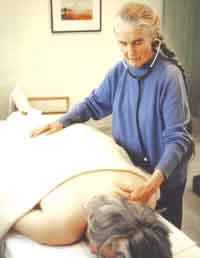
Softening the 'armoured' trapezius
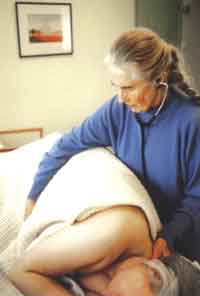
Encouraging intestinal psychoperistalsis by 'polarization'
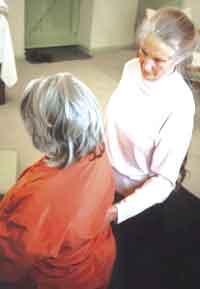
Supporting the client's strength and confidence
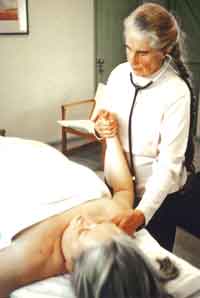
Loosening the neurotic self-restriction in the shoulder
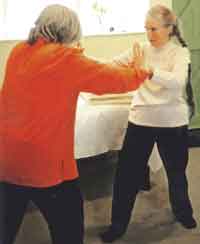
Encouraging the client to claim the space she needs
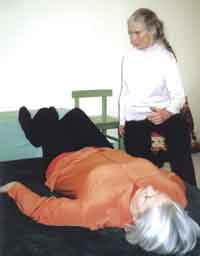
Kicking against restrictions
More About Gerda Boyesen
Gerda Boyesen's work reflects her character: profoundly alive and respectful of life, deeply intelligent, always ready to explore and be surprised, responding to the moment rather than to any rigid structure, and with the simplicity arising from going to the essence of life. She has a profound wisdom, and an incredible capacity – unique in my experience – for reaching through to a person's true inner nature and helping it to flower. Catatonic patients speak, the apparently unlovely and unlovable become positively beautiful.
To spend time with Gerda is to find oneself lighter in heart, refreshed, inspired, and enjoyably stimulated. She has a most delicate discrimination of the very different levels of human life and meaning: what is to be taken seriously, and what is to be taken lightly; the 'tragic' and the 'trivial' levels of life. Had she not become a psychotherapist, she would love to have been a cabaret singer.
Gerda Boyesen's first students were her two daughters and her son. After she moved to London in 1968 she began teaching her methods more widely, with students coming from as far afield as Australia and South America. In 1975 she established the Gerda Boyesen Centre in Acton Park, London, which was the 'mother house' of her work for over two decades. In the later 1970s her work spread to Holland, France, Germany and Switzerland, where she and her family established more training groups. The biodynamic approach is now also taught in Venezuela, Brazil, Australia and the west coast of the USA.
In 2000, at Gerda Boyesen's request, the independent non-profit London School of Biodynamic Psychology was established, to take over responsibility for the five-year diploma level training course in biodynamic psychotherapy. Gerda herself, 79 this year, works as intensively as ever, giving therapy, teaching and writing, and is still developing new theories and methods.
Further Information
For further information, tel: 07000 794 725, e-mail: enquiries@lsbp.org.uk, visit www.lsbp.org.uk, or write to the London School of Biodynamic Psychotherapy, Willow Cottage, off Wokingham Road, Hurst, Berks RG10 0RU.
Comments:
-
Guenola Pinel said..
I live in Maidenhead, Berkshire. Can you tell me if there is biodymanic psychotherapist in my area or where could I find the closest one?
Thank you
-
Anne ronjat said..
Hi,
I live in Australia, Melbourne and I seem to have difficulties finding biodynamic psychotherapists. Would you be able to recommend any in Melbourne?
Many thanks, Anne